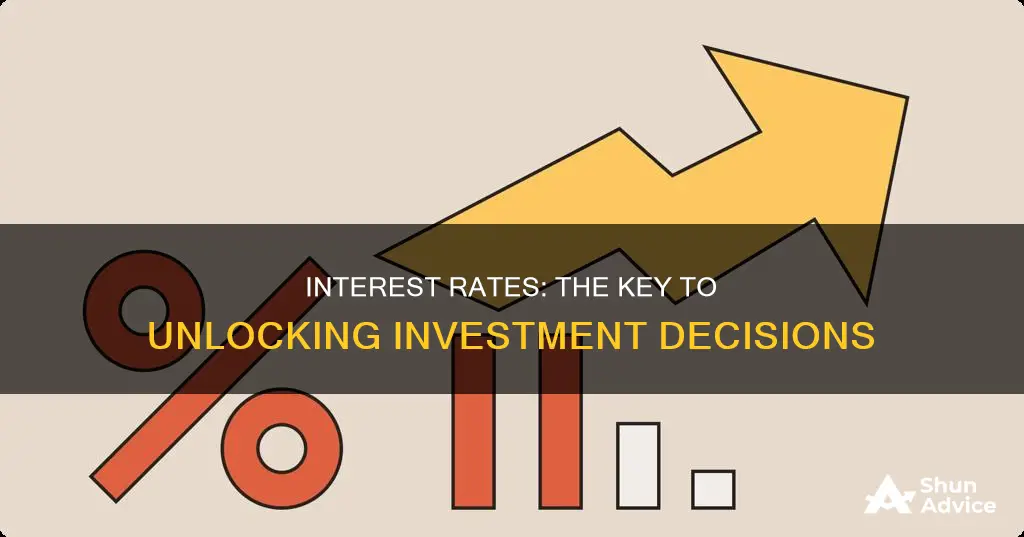
Planned investment is a critical component of economic growth, and its trajectory can be significantly influenced by changes in interest rates. Interest rates play a pivotal role in shaping investment decisions as they directly impact the cost of borrowing and the potential returns on investments. When interest rates rise, borrowing becomes more expensive, which may discourage businesses from making new investments, especially in long-term projects. Conversely, lower interest rates can stimulate investment by making borrowing cheaper and more attractive, encouraging businesses to expand their operations or invest in new ventures. Understanding the relationship between interest rates and investment is essential for businesses, policymakers, and investors alike, as it can help guide strategic decisions and manage financial risks effectively.
What You'll Learn
- Economic Theory: How changes in interest rates affect investment decisions
- Market Sentiment: The impact of interest rate fluctuations on investor confidence
- Credit Availability: How interest rate shifts influence access to loans and credit
- Asset Pricing: The relationship between interest rates and asset values
- Government Policies: How monetary policy and interest rate adjustments influence investment

Economic Theory: How changes in interest rates affect investment decisions
Interest rates play a pivotal role in shaping investment decisions, and understanding this relationship is essential for investors, businesses, and policymakers alike. When central banks adjust interest rates, it sends a powerful signal to the economy, influencing the cost of borrowing, the attractiveness of savings, and the overall investment landscape. This phenomenon is a cornerstone of economic theory, particularly in the field of monetary economics.
In the context of investment, interest rates act as a lever that can either encourage or discourage spending and investment. When interest rates are low, borrowing becomes cheaper, and this often stimulates investment as businesses and individuals are more inclined to take on debt to finance projects, purchases, or expansion. Lower interest rates can lead to a surge in investment spending, driving economic growth and potentially leading to inflationary pressures. This is because increased investment can lead to higher demand for goods and services, causing prices to rise.
Conversely, when interest rates rise, the cost of borrowing increases, which can have a cooling effect on investment. Higher interest rates make loans more expensive, potentially discouraging businesses from expanding or individuals from making significant purchases. This can lead to a slowdown in investment activity, as the return on investment may become less attractive compared to the increased cost of capital. As a result, businesses might opt to save more and invest less, which can contribute to a decrease in aggregate demand and potentially lead to a recession if sustained over an extended period.
The relationship between interest rates and investment is a delicate balance. Central banks often use interest rates as a tool to manage economic growth and inflation. For instance, during economic downturns, central banks may lower interest rates to encourage borrowing and investment, stimulating the economy. Conversely, when an economy is overheating and inflation becomes a concern, central banks might raise interest rates to curb excessive spending and investment. This strategic adjustment of interest rates can help maintain economic stability and guide the market towards a desired trajectory.
In conclusion, interest rate changes have a profound impact on investment decisions, influencing the overall economic environment. Understanding this dynamic is crucial for economic theory and practice. It highlights the importance of monetary policy in managing economic cycles and the delicate task of central banks in ensuring a healthy and sustainable economic growth path. By recognizing the effects of interest rates on investment, policymakers and investors can make more informed decisions, contributing to a more robust and resilient economy.
Unraveling the Elasticity of Investment Interest: A Comprehensive Analysis
You may want to see also

Market Sentiment: The impact of interest rate fluctuations on investor confidence
Interest rate fluctuations have a profound impact on market sentiment and investor confidence, which, in turn, significantly influences planned investment decisions. When central banks adjust interest rates, it creates a ripple effect across the economy, affecting various sectors and market participants. For investors, interest rates are a critical factor in their decision-making process, as they directly influence the cost of borrowing, the potential returns on investments, and the overall economic environment.
During periods of rising interest rates, market sentiment often becomes more cautious. Higher interest rates typically lead to increased borrowing costs, which can reduce the attractiveness of certain investments, especially those with fixed returns or those that rely on debt financing. As a result, investors may become more selective in their choices, favoring safer assets or those with the potential for higher returns that can outpace the rising interest rates. This shift in sentiment can lead to a decrease in investment activity, particularly in sectors that are highly sensitive to interest rate changes, such as real estate, consumer loans, and certain financial instruments.
Conversely, when interest rates are lowered, investor confidence tends to surge. Lower interest rates make borrowing cheaper, encouraging businesses and individuals to take on more debt, which can stimulate investment. This environment often attracts investors who seek to capitalize on the potential for higher returns in various asset classes. For instance, stocks may become more appealing as lower interest rates can lead to increased corporate profitability and a more favorable borrowing environment for businesses. Similarly, fixed-income investments like bonds might lose their appeal as their yields become less competitive compared to the lower interest rates offered by banks.
The relationship between interest rates and market sentiment is complex and often interwoven with other economic factors. Investors consider not only the absolute level of interest rates but also the direction of change and the overall economic outlook. For instance, a central bank's decision to raise rates in response to inflationary pressures might be seen as a positive sign by investors, indicating a healthy economy and potential for sustained growth. However, if the same rate hike is perceived as a sign of economic weakness or an impending recession, it could trigger a negative sentiment shift, causing investors to reevaluate their investment strategies and potentially leading to a flight to safer assets.
Understanding the dynamics of market sentiment in response to interest rate changes is crucial for investors and financial analysts. It allows for more informed decision-making, helping to navigate the potential risks and opportunities presented by interest rate fluctuations. By staying attuned to these sentiment shifts, investors can adjust their investment portfolios accordingly, ensuring a more balanced and strategic approach to capital allocation.
Maximizing Returns: A Guide to Claiming Interest on Your Investment Loan
You may want to see also

Credit Availability: How interest rate shifts influence access to loans and credit
Interest rates play a pivotal role in the credit availability landscape, significantly impacting the ease of access to loans and credit for individuals and businesses alike. When central banks adjust interest rates, this decision reverberates through the financial system, affecting borrowing costs and, consequently, the flow of credit. During periods of rising interest rates, borrowing becomes more expensive, which can lead to a reduction in the demand for loans. This dynamic is particularly relevant for businesses planning investments, as higher interest rates may discourage them from taking out loans to finance expansion or new projects. As a result, the overall credit demand may decrease, potentially limiting the availability of credit for those seeking to invest.
Conversely, when interest rates are lowered, borrowing becomes more attractive and affordable. This shift can stimulate the economy by encouraging businesses to invest in growth and expansion. Lower interest rates make loans more accessible, allowing companies to finance their projects without incurring excessive costs. This increased credit availability can drive economic activity, as businesses are more inclined to take on debt to fund their plans. For individuals, lower interest rates can also mean better terms for personal loans, making it easier to finance major purchases or consolidate debt.
The relationship between interest rates and credit availability is a delicate balance. While lower interest rates can boost economic activity, they must be carefully managed to avoid potential pitfalls. If interest rates drop too low, it can lead to excessive borrowing, potentially causing an economic bubble. On the other hand, higher interest rates, while making borrowing more expensive, can also reduce the risk of default and stabilize the financial system.
For investors and businesses, monitoring interest rate changes is essential. A shift in interest rates can significantly impact the cost of borrowing, affecting the feasibility of planned investments. For instance, a sudden increase in interest rates might prompt businesses to reevaluate their investment strategies, potentially delaying or scaling back projects. Conversely, a decrease in interest rates could encourage more aggressive investment, provided that the economic environment and market conditions are favorable.
In summary, interest rate shifts have a profound impact on credit availability and, consequently, on the investment landscape. Understanding these dynamics is crucial for businesses and individuals alike, as it enables them to make informed decisions regarding borrowing and investment. By staying informed about interest rate changes and their potential effects, market participants can navigate the credit market more effectively and adapt their strategies accordingly.
Interest Rates, Investment, and the Aggregate Expenditure Plan
You may want to see also

Asset Pricing: The relationship between interest rates and asset values
The relationship between interest rates and asset values is a fundamental concept in asset pricing, and understanding this dynamic is crucial for investors and financial analysts. When interest rates change, it has a ripple effect on various asset classes, influencing investment decisions and market behaviors. Here's an exploration of this relationship:
Interest rates play a pivotal role in determining the attractiveness of different investment options. When central banks adjust interest rates, it directly impacts the cost of borrowing and the potential returns on investments. Higher interest rates often lead to increased borrowing costs, making it more expensive for individuals and businesses to take out loans. As a result, they may opt for safer, lower-risk investments like government bonds, which offer a fixed return. This shift in demand can cause a rise in bond prices, making them more valuable. Conversely, during periods of low or declining interest rates, borrowing becomes cheaper, potentially stimulating economic activity and encouraging investors to seek riskier assets with higher potential returns.
In the context of asset pricing, the relationship is often described by the term 'duration'. Duration measures the sensitivity of the price of a fixed-income security or an asset portfolio to changes in interest rates. For instance, long-term bonds typically have a higher duration, meaning their prices are more volatile in response to interest rate fluctuations. When interest rates rise, the prices of these long-term bonds fall, and vice versa. This inverse relationship is a key consideration for investors, especially those managing bond portfolios or fixed-income securities.
Equity investments, such as stocks, also respond to interest rate changes, but the relationship is more complex. Lower interest rates can stimulate economic growth, potentially leading to increased corporate profits and higher stock prices. However, rising interest rates might discourage borrowing, potentially impacting business investments and growth. Investors must consider the overall economic environment and the specific sectors or industries within the stock market that may be more or less sensitive to interest rate shifts.
Additionally, the impact of interest rates on asset values can vary across different markets and regions. Local economic conditions, inflation rates, and government policies all play a role in moderating the effects of interest rate changes. For instance, in a country with high inflation, central bank rate hikes might have a more pronounced effect on asset prices compared to a stable or low-inflation environment.
In summary, interest rates are a critical determinant of asset values and investment strategies. Investors must stay informed about interest rate trends and their potential impact on various asset classes to make well-informed decisions. Understanding this relationship is essential for managing risk and optimizing investment portfolios, especially in dynamic economic environments.
Interest Rates: Investment Homes vs. Second Homes: What's the Difference?
You may want to see also

Government Policies: How monetary policy and interest rate adjustments influence investment
The relationship between government policies, particularly monetary policy, and interest rates, is a critical factor in shaping planned investment decisions. When a central bank adjusts interest rates, it sends a powerful signal to the market, influencing the cost of borrowing and the overall economic environment. This, in turn, impacts businesses' decisions to invest in new projects, expand operations, or maintain a status quo.
Monetary policy, which involves managing the money supply and interest rates, is a tool used by governments to achieve economic objectives. One of its primary goals is to stimulate economic growth and control inflation. When a central bank decides to lower interest rates, it becomes cheaper for businesses and individuals to borrow money. This reduction in borrowing costs encourages investment as projects that were previously deemed unprofitable due to high-interest rates may now become viable. Lower interest rates can lead to increased investment in infrastructure, technology, and other capital-intensive projects, as businesses find it more affordable to finance these ventures.
Conversely, raising interest rates can have a cooling effect on the economy and investment. Higher interest rates make borrowing more expensive, which may discourage businesses from investing in new projects. This is especially true for long-term investments, as the cost of capital increases. As a result, companies might delay expansion plans or opt for more conservative strategies, focusing on cost-cutting measures instead. This shift in business behavior can impact overall economic growth and development.
Interest rate adjustments also influence investment through their impact on asset prices. When interest rates rise, the value of existing assets, such as property or stocks, may decrease relative to the cost of new loans. This can prompt investors to reconsider their portfolios and potentially shift their focus to different asset classes. For instance, a rise in interest rates might encourage investors to move from bonds to stocks, as the higher rates make borrowing more attractive for business investments.
In summary, government policies, particularly monetary policy, play a pivotal role in shaping investment decisions. Interest rate changes are a powerful mechanism through which these policies influence the economy. Lower interest rates stimulate investment by reducing borrowing costs, while higher rates may discourage new projects. Understanding these dynamics is essential for businesses and investors alike, as it allows them to make informed choices and adapt their strategies in response to changing government policies and economic conditions.
Mastering Private Equity: Crafting Your Investment Sheet
You may want to see also
Frequently asked questions
Interest rate changes can significantly influence planned investment strategies. When interest rates rise, borrowing becomes more expensive, which may discourage businesses from taking on new loans for expansion or major projects. Higher interest rates can also reduce the attractiveness of fixed-income investments, leading investors to seek alternative, potentially higher-yielding opportunities. This shift in investment behavior can impact the overall economic outlook and market sentiment.
Yes, lower interest rates often stimulate investment. With reduced borrowing costs, businesses may find it more financially viable to invest in new projects, infrastructure, or research and development. Lower rates can also encourage investors to take on more risk, as the opportunity cost of holding cash decreases. This can lead to increased capital spending and a boost in economic activity.
Central banks play a crucial role in managing interest rates to guide economic growth and investment. By adjusting interest rates, central banks can influence the cost of borrowing, which in turn affects investment decisions. For instance, during economic downturns, central banks may lower interest rates to encourage borrowing and investment, stimulating the economy. Conversely, in times of high inflation, raising interest rates can discourage borrowing and potentially reduce investment spending.
Interest rate changes can have lasting effects on investment portfolios, especially in the bond market. When interest rates rise, existing bonds with lower coupon rates become less attractive, causing their prices to fall. This can impact mutual funds, exchange-traded funds (ETFs), and other fixed-income investments that hold these bonds. Investors may need to adjust their portfolios to accommodate changing interest rates, potentially selling bonds and reallocating funds to take advantage of new opportunities or mitigate losses.







